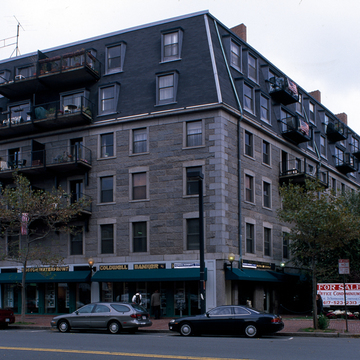Originally the site of Clarks Wharf (after merchant Thomas Clark built a pier here in the mid-seventeenth century), it became the property of Thomas Hancock in 1761 and was renamed Hancock Wharf. In 1764, his nephew John Hancock inherited the wharf, together with warehouse and store. By 1836–1840 the Quincy granite Lewis Wharf structures were added, and after 1850 it was a center for the clipper-ship trade with China, Australia, Hawaii, and Europe. Part of the wharf was destroyed for the building of Atlantic Avenue between 1869 and 1872. It has been renovated for residential use, and the original gable roof has been altered with two stories of poorly designed apartments. Edgar Allan Poe's “Fall of the House of Usher” was based on events at the North End Coffee House, located opposite the head of the wharf until its demolition in 1973.
You are here
Lewis Wharf
1836–1840, Richard Bond; 1865–1869 restored for commercial use; 1971, Carl Koch and Associates. 28–32 Atlantic Ave.
If SAH Archipedia has been useful to you, please consider supporting it.
SAH Archipedia tells the story of the United States through its buildings, landscapes, and cities. This freely available resource empowers the public with authoritative knowledge that deepens their understanding and appreciation of the built environment. But the Society of Architectural Historians, which created SAH Archipedia with University of Virginia Press, needs your support to maintain the high-caliber research, writing, photography, cartography, editing, design, and programming that make SAH Archipedia a trusted online resource available to all who value the history of place, heritage tourism, and learning.


